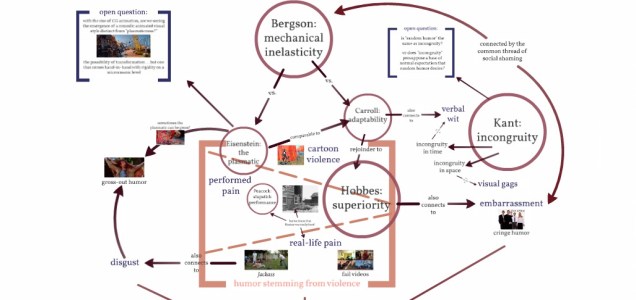Hobbes
Postmortem: Comedy and the Moving Image

Ian here—
Grades for the School of the Art Institute of Chicago’s Fall 2016 semester were due today, and I wanted to take the occasion to do a quick postmortem on “Comedy and the Moving Image,” which I consider to be the most successful course I taught this term—as well as one of my most fun and productive courses ever taught. I’ve posted several lesson plans from this course already throughout the past couple of months. Links to those will be provided below, as I sketch out a skeletal version of the course’s themes, and some of its most interesting surprises.
I put this visual presentation together for our final class meeting. You should feel free to follow along with it … although I admit that, as you can see from the above image, it gets increasingly messy as you click through.
Lesson Plan: Sadism, Identification, Comedy, Videogames

Ian here—
One of my primary reasons for designing my course “Comedy and the Moving Image” for the School of the Art Institute of Chicago’s first-year seminar sequence was to give myself an opportunity to expand my knowledge base on comedy beyond the research I had done for my article on comedic videogames. The class gave me an opportunity to teach a whole bunch of readings, films, video art pieces, and television episodes I had never taught before. By the twelfth week, though, the time had come to turn back to my particular hobbyhorse.
In the lead-up to this class, I had screened a few stunts from the Jackass franchise. This included “Paper Cuts” from Jackass: The Movie (Jeff Tremaine, 2002) and “Tee Ball” from Jackass 3D (Jeff Tremaine, 2010). The first half of class was organized around discussions of violence and sadism in physical humor, propped up not only by Jackass but also by Muriel Andrin’s chapter “Back to the ‘Slap’: Slapstick’s Hyberbolic Gesture and the Rhetoric of Violence” and Scott Richmond’s article “‘Dude, That’s Just Wrong‘: Mimesis, Identification, Jackass.” In the second half of the course, things segued into small group work as students played and discussed a group of comedic videogames.
You can follow along with the visual presentation for this lesson here.
Lesson Plan: Henri Bergson’s Theory of Humor
Ian here—
The following is a lesson plan for a day spent discussing Henri Bergson’s theory of humor in my course “Comedy and the Moving Image.”[i] It’s admittedly unusual, but I found it to be wonderfully productive.
The first third or so of this course was spent discussing some major philosophical theories of humor (Hobbes, Kant, Bergson) and watching silent slapstick comedy shorts. Knowing that devoting a solid block of class to silent cinema came with the danger of alienating students, I also spiced things up by showing a lot of contemporary YouTube videos in class, which kept them engaged. (The “fail video” genre makes a terrific pairing with Hobbes’ theory of humor!) You’ll see some of that back-and-forth in this lesson.

